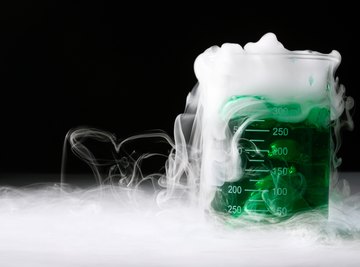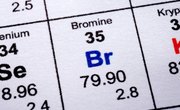
One chemical method of determining the identity of an unknown is by using spot tests to determine how it reacts with particular compounds. These tests react with only one or two types of compounds, so you can glean information about the possible type of compound the unknown is. One test that identifies alcohols is the test with Lucas Reagent. The Lucas Reagent reacts differently with the alcohol depending on the number of carbon atoms bonded to the carbon atom that contains the alcohol group. To obtain valid results, the Lucas Reagent must be prepared fresh each day.
- Goggles
- Apron
- Gloves
- 400 ml beaker
- Ice
- 100 ml beaker
- 50 ml graduated cylinder
- Concentrated HCl
- Balance
- Oven
- Dessicator
- Anhydrous ZnCl2
- Glass stirring rod
- 150 ml bottle
Avoid skin contact from the concentrated HCl or the Lucas Reagent. If you get it on your skin, flush with copious amounts of water.
Put on all the safety equipment before beginning the preparation of Lucas Reagent. Due to the hazardous nature of the concentrated HCl, you must guard against injury. Put on the goggles, rubber apron and rubber gloves. Adjust these items to fit you and ensure they will not get in your way or hamper you from performing any of the tasks required during the preparation.
Place a 400 ml beaker on the bench and fill it half way with ice. Pour a small amount of water into the beaker with the ice.
Pour the concentrated HCl into the 50 ml graduated cylinder. Measure out 47 ml of concentrated HCl and pour it into the 100 ml beaker.
Place the 100 ml beaker in the ice bath in the 400 ml beaker. This will absorb the heat generated during the dissolution of the ZnCl2.
Weigh out 62.5 gm of anhydrous ZnCl2 from the cooled weighing bottle using a laboratory balance. Dry the stock ZnCl2 in an oven inside a weighing bottle for at least two hours. Cool the ZnCl2 anhydrous in a dessicator to prevent air contact.
Add the ZnCl2 to the hydrochloric acid in the beaker slowly. Stir the mixture with a glass stirring rod until the ZnCl2 dissolves. Add the ZnCl2 slow to avoid the mixture overflowing the sides of the small beaker. Adding the solid too fast will cause the solution to foam.
Pour the Lucas Reagent into the 150 ml brown storage bottle. Label the bottle immediately so that it doesn’t get mislabeled.
Things You'll Need
Warnings
Warnings
- Avoid skin contact from the concentrated HCl or the Lucas Reagent. If you get it on your skin, flush with copious amounts of water.
About the Author
Sean Lancaster has been a freelance writer since 2007. He has written for Writers Research Group, Alexis Writing and the Lebanon Chamber of Commerce. Lancaster holds a Doctor of Philosophy in chemistry from the University of Washington.
Photo Credits
Jupiterimages/Photos.com/Getty Images
